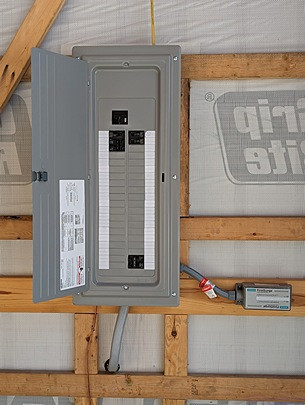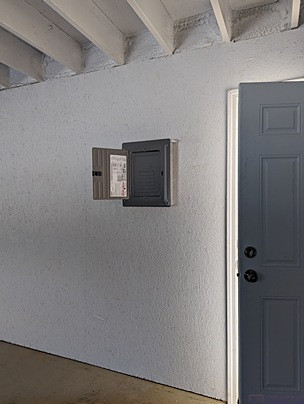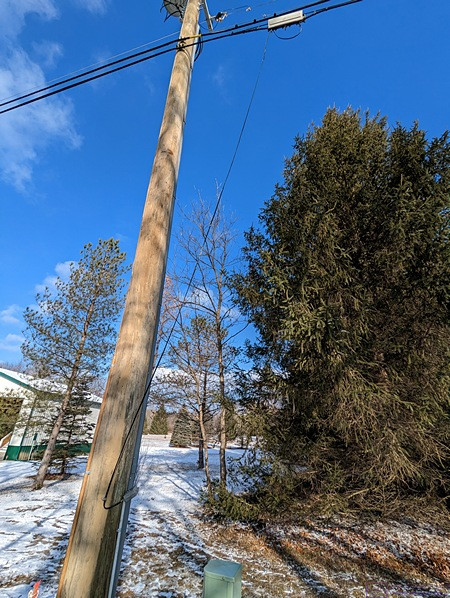[ There are 3 photos in this post. ]
TUESDAY 24 January – SUNDAY 29 January
When the Motor City Electric Utilities crew finished their work on Monday the 23rd, the project was well on its way to completion, but not quite finished as we still did not have power to the barn. During the week, I got an e-mail from our DTE planning consultant with contact information for the “case manager” who would schedule the work, and letting me know that I would now be dealing with her from now on. I e-mailed her and introduced myself, and cc:d the planning consultant. I included photos, and let them know the work was almost completed, and that all that remained to be down was to pull the underground service conductors from the barn meter enclosure to the pedestal, terminate them at both ends, and install the meter. Once again, the reply that I received was basically “what?”
By this point, and after discussion with some friends, I had come to the conclusion that my customer satisfaction survey reply, and subsequent conversation with a customer service representative, appeared to have triggered a response from DTE. While I was glad that the work was getting done, I was saddened that the people responsible for planning and scheduling the job, and with whom I had worked closely, appeared to be unaware that the work was taking place. Indeed, the planning consultant indicated that he had only just released the work orders for scheduling. And that was not right; it’s never right to bypass people. Go through the reporting chain to the people responsible and make a higher priority of the work, sure, but do not go around them.
Sometime during this week, the builder also got word that the roll-up doors would not be available by the end of the month and he was trying to pin down a delivery date. At this point, it almost didn’t matter. We would be traveling from late February to early March, and I would not be starting the wiring until we got back. In fact, I had to do some painting even before the electrical work, which I couldn’t do until the temperatures were warmer and would stay that way overnight. Also, I had no interest in doing electrical work in the cold and neither did Marty, who offered to come down and help.

The main load center for the barn with the Siemens FirstSurge device mounted externally, lower right and connected to a 2-pole, 20 Amp circuit break, lower right in the enclosure. This was the only wiring I intended to do on the barn before apply for an electrical permit in mid-June, but I wanted this device in place before the electrical service was energized.
I did, however, manage to accomplish two small things in the barn this week. A while back I bought a Siemens FirstSurge Type 2 “whole house” surge protective device (SPD) and wanted to install it in the main service panel for the barn before utility power was connected to it. Type SPDs get installed after (downstream of) the main disconnecting means, which in this case is the 200 Amp main breaker in the Siemens load center.
The unit is large at approximately 3” x 6” by 2” deep. It is a sealed unit, with four wires coming out a female threaded stud. I had intended to mount it directly to one of the knockouts on the load center, using a male threaded adapter from inside the enclosure, but I ultimately decided against that approach.
As shown in the photo, I ended up mounting it with four screws to one of the horizontal skags that the enclosure (and the siding) is attached to, and connecting it to the enclosure using a 12” piece of liquid-tight flexible non-metallic conduit. The two hot leads from the device were wired to a 2-pole, 20 Amp circuit breaker, installed in the lowest two positions in the right circuit break bank. (The neutral and equipment grounding conductors were terminated in the usual way.)
Type 2 SPDs are also available in circuit breaker form, which is the most convenient way to add one to an existing panel. However, I really liked the more robust specifications of the FirstSurge device.

The sub-panel on the south wall of the shop just east of the door. This is a lug-style panel (no main circuit breaker) that will be fed from a 100 Amp 2-pole circuit breaker in the main load center through fairly large feeder cables. Although both the bus and the travel trailer have 240V/50A (120V/100A) electrical systems, most of the power used in the barn will be used in the shop.
The other thing I accomplished in the barn was hanging the sub-panel in the shop. No wiring was involved; just deciding exactly where I wanted to place the enclosure. I wanted it to be convenient to the door, but comfortable, as I will be using many of the circuit breakers as switches. But I also had to make sure the location was compliant with the NEC.
Last, but not least, I continued to read the 2023 NEC Handbook and started working again on the electrical plan for the barn, as well as researching light fixtures and other devices for the project.

As an aside, The Motor Cities Electric Utilities crew on the 23rd, reattached the riser conduit for the AT&T cable and terminal box to the new pole as best they could. They stapled the cable to the pole about a foot above the terminal box, as that was as much slack as they had to work with. If you look closely you can see the wire goes directly (through air) from there to the junction block on the main cable. It should be stapled all the way up the pole, but that will require a longer wire. I was told that it would be up to AT&T to remedy this, ditto for Comcast if it involves their cables, but that I might have to call these companies myself and be “persistent” in getting them to come out and do something about it. Ugh. I just don’t see why I should have to deal with that situation. Presumably DTE reports to Comcast & AT&T that they have replaced this pole and additional work needs to be done.
…